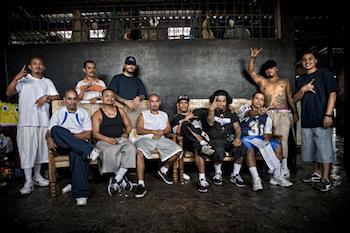A new report seems to indicate that various branches of the MS13 gang in El Salvador attempted to pool their resources in order to fund an elite unit as a response to a government crackdown on their operations.
An October 11 article published by El Diario de Hoy reported that telephone conversations intercepted by Salvadoran authorities appear to show MS13 leaders plotting to train and equip the unit using funds derived from the criminal activities of the gang’s various “clicas,” or cliques. The conversations were intercepted as part of “Operación Jaque” (Operation Check), an ongoing investigation launched in 2015 that initially targeted the MS13’s financial structures and continues to provide a vast amount of information concerning various aspects of the gang’s organization.
The Salvadoran Attorney General’s Office had previously filed a report in August 2016 alleging that suspected MS13 leader, Marvin Adaly Quintanilla Ramos, alias “Piwa,” had planned to create an elite unit composed of 500 gang members, with the two best foot soldiers from each of the gang’s 249 nationwide cliques being recruited, trained and equipped with high-powered rifles. The plan was apparently fomented as a response to the government’s decision to increase prison security measures, and in particular to cut off incarcerated gang leaders’ communications with the outside world.
SEE ALSO: Coverage of Prisons
But the report from El Diario de Hoy suggests that the formation of the elite unit was part of a larger plot by the MS13 aimed at reducing the impact of the “extraordinary measures.”
According to the news outlet, the MS13’s “Plan A” came about after the gang learned of the government’s intention to implement a new penitentiary policy two weeks before the official announcement in April 2016.
In response, MS13 leaders reportedly joined forces with their rivals in the Barrio 18 gang to identify the new security measures with which they would be targeted, and they subsequently publicly ordered their members on March 26 to stop gang-related killings in the hope that the government would backtrack. “Plan A” reportedly made clear that this action had to be promoted through the media as a show of goodwill on behalf of the gangs.
Yet while “Plan A” initially succeeded in lowering the level of violence in the country, it apparently did not affect the government’s intention to clamp down on incarcerated gang leaders. Nevertheless, El Diario de Hoy reported, MS13 leaders had also prepared a “Plan B.”
“Plan B” allegedly consisted of creating a fund to pool all the illicit proceeds of the gang’s nationwide activities over the course of a month. This fund, which reportedly reached the sum of $600,800, was meant to serve as the financial resource needed for the creation of the 500-man unit. The money appears to have been intended to finance the training of the unit’s operatives and the acquisition of military-grade equipment, including high-powered firearms, explosives and weapons to shoot down helicopters.
In two intercepted phone calls made by Piwa to other suspected MS13 leaders towards the end of March, the now-incarcerated protagonist reportedly said that making contributions to the fund was mandatory, and that due to the clicas’ vast annual resources, transferring money to the fund once or twice per year on the basis of a month’s worth of extortion money would give the gang the resources necessary to fight back against the state and its institutions.
The ultimate phase of the MS13’s strategy, “Plan C,” reportedly involved the actual use of the elite unit to commit attacks against various public and private institutions in what would have amounted to a terror campaign and a high-intensity conflict against the government. Apparently, however, this phase of the plan was never realized.
InSight Crime Analysis
Although reports of the MS13’s attempted creation of an elite unit had already surfaced, the revelations surrounding the unit’s funding through the nationwide pooling of extortion money suggest that gang leaders were taking concrete steps toward building such an armed faction. However, there are several factors that would have made this plan difficult to execute, most notably the gang’s horizontal structure and lack of centralized leadership.
Still, it is concerning that MS13 leaders appear to have been plotting a coordinated assault on El Salvador’s public institutions. Violent confrontations between gangs and security forces have occurred at a rate of more than one per day in 2016, and El Salvador had already registered at least 4,000 homicides as of September. If the gang’s “Plan C” had come to fruition, violence in El Salvador would likely have skyrocketed from the attacks by the militarized elite unit, cancelling out the slight but steady reduction in reported killings observed this year compared to last.
SEE ALSO: El Salvador News and Profiles
The level of confidence and ambition with which the MS13 reportedly fomented a plan to intensify their conflict with the state is worrying to say the least. But it is interesting to observe that this was averted, in part, due to the unfolding of an investigation that originally targeted the gang’s financial structure.
Latin American governments, including El Salvador, have often turned to militarized strategies in order to confront organized crime. Yet these strategies often have adverse consequences for human rights and fail to have sustainable impacts on levels of violence or the presence of criminal organizations.
Targeting the finances of criminal organizations could thus represent an alternative but effective strategy to diminish their power by hitting their most crucial resource. Such a strategy may also help avoid increasing the level of violence associated with criminal activity by not only avoiding the intensification of conflict between the state and criminal groups, but also by chipping away at criminals’ ability to acquire increased manpower and firepower.

